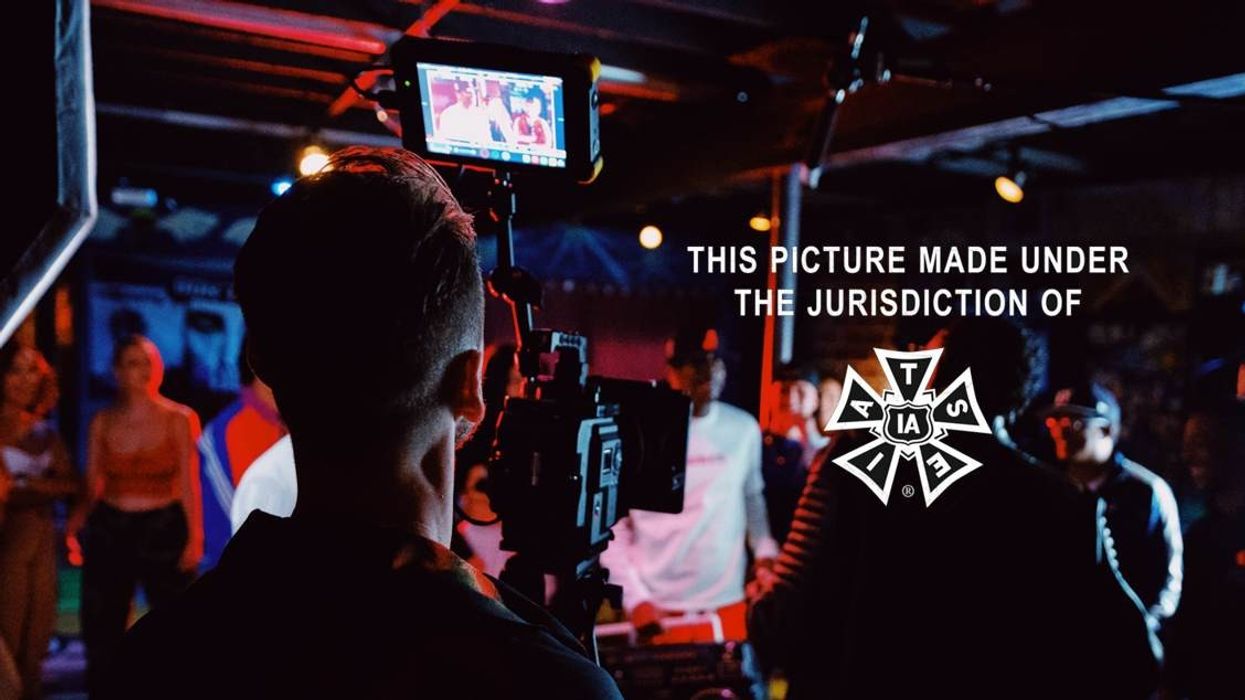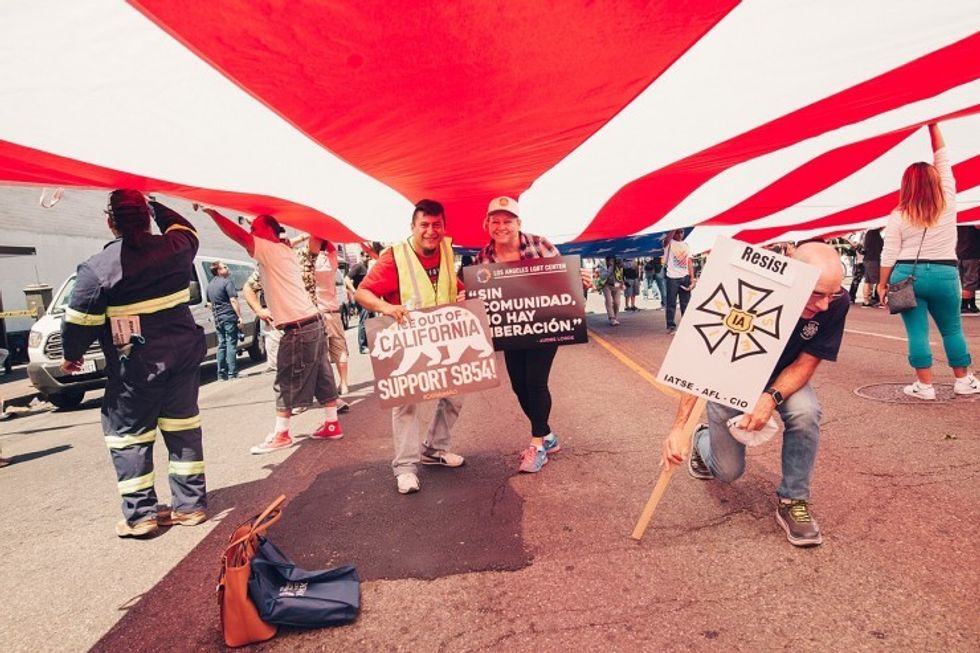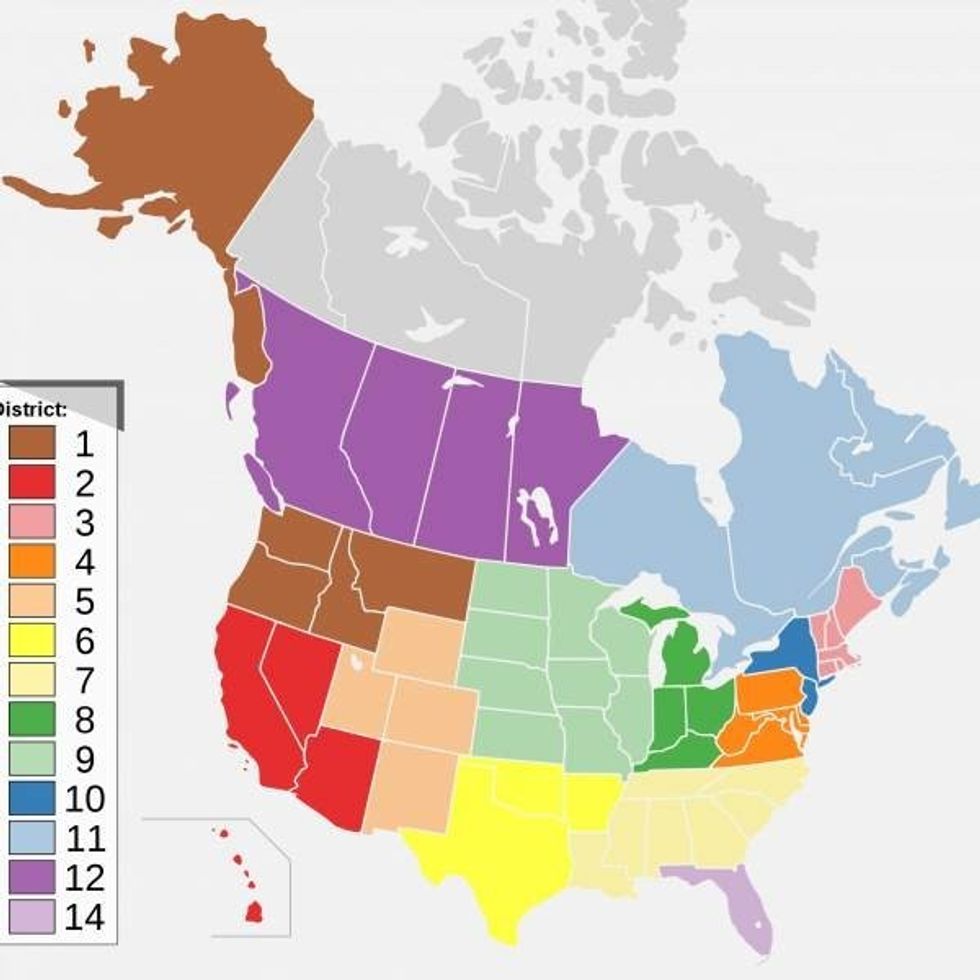What Is IATSE? An Explainer
We've all seen it before. "This picture made under the jurisdiction of IATSE" is almost as ubiquitous as the MGM lion himself.

With the strike authorization vote announced this week and continuing drama between Hollywood unions over a fight for better working conditions, we wanted to make sure our readers were up to speed in case some have never heard the word "IATSE" before now.
What is IATSE? Who is in this union? What would a strike mean for entertainment? We will tell you.
Let's dig in!
What Is IATSE? Union Origins and Charter
In 1893, 11 industry leaders working nationwide got together to form a more perfect union of American stagehands. They shared what they perceived to be the biggest challenges facing them in their trade. Together, they wrote the handbook on the rights of those working in every area of entertainment.
A standard was established in the entertainment industry for the first time. Their founding manifesto vision included a system of local unions for stagehands, minimum living wages for all of their members, and fair working conditions, no matter what.
This pivotal endeavor now protects all professionals working in entertainment media, extending its reach far beyond IATSE's humble beginnings in theatre exclusively. If a future in film production is your dream, IATSE membership is definitely something that you should strive for.
What Does IATSE Stand For?
IATSE's full name: the International Alliance of Theatrical Stage Employees, Moving Picture Technicians, Artists and Allied Crafts of the United States, Its Territories and Canada. Quite a mouthful.
IATSE is a labor union that represents over 140,000 professionals in all of the categories above. These types of workers are called "below-the-line" workers in the industry—"above-the-line" workers referring to on-screen talent, directors, producers, and writers.
IATSE categorizes each of its members into one of several departments.
The IATSE Motion Picture and Television Production Department
Filmmaking can be kind of dangerous. Luckily, IATSE is here to keep us all in line.
The IATSE Motion Picture and Television Production Department specializes in protecting enthusiastic filmmakers from themselves by laying down the law when it comes to things like humane working hours and turnaround time, mandatory second meals, child endangerment, and strict fire and stunt regulations.
Those who remember Slates for Sarah know that safety on set is very important. IATSE provides guidance and authority whenever the safety of any member of the crew is on the line.
Film sets are either union or non-union productions. Any work done on a union set contributes to a member’s mandatory minimum requirement of union days for IATSE eligibility.
The IATSE Stagecraft Department
Those working behind-the-scenes during live-event productions can be represented legally by the IATSE Stagecraft Department. This includes not only any stagehand or back-of-house managers, but also those working as ushers or box office clerks in the front of the house, as well.
The IATSE Stagecraft Department is the oldest division of IATSE. It's been the heart of the organization since the day that it was founded.
The IATSE Tradeshow Department
Much like IATSE stagehands, tradeshow workers are responsible for live event accommodations and other exhibitions of that nature. It's difficult work, putting these vulnerable workers in great need of protection from long hours and brutal manual labor. IATSE is more than happy to oblige.

The IATSE Broadcast Department
Broadcast work includes any live, studio-recorded event, such as a live sports event or a serialized cable news show. These workers are also considered IATSE-eligible.
What Does IATSE Do?
Like all trade unions, the IATSE union protects the rights of those working in entertainment and media—the tough stuff most certainly included. Each chapter acts as a local hub of the industry and often provides IATSE health and welfare for their constituents directly, as well as other services and support.
IATSE is a totally democratic organization. Each member has a say in the decision-making process that IATSE is governed by, even if only at the local level.
There is a distinct spirit of individual empowerment behind the IATSE political philosophy. All for one, and one for all.
What Is a Local Union?
With any organization as large as IATSE, it's usually best to split everybody up into smaller groups called "locals." Each local branch can focus more intently on issues that may be sector- or region-specific.
The interests of the union at the international level are upheld without steamrolling more niche needs. It's a system that works well.
Currently, there are 366 IATSE local unions in the United States and Canada. Every chapter functions as an independent 501(c)5 nonprofit, complete with its own elections, bylaws, and constitutions.
Some of the most prominent IATSE locals:
- IATSE Local 80: This IATSE local chapter represents those in entertainment media. They're based in Burbank, California, serving the greater Hollywood area. Included here are grips, crafts services, first aid, and warehouse workers—anybody on a film crew.
- IATSE Local 871: Three thousand broadcast and film workers strong, IATSE 871 is based proudly in Burbank, California, as well. Alive with the progressive spirit of LA, this IATSE local involves itself intimately with advocacy and the wellbeing of its constituents.
- IATSE Local 728: Also based in Burbank, IATSE 728 is the studio electrical lighting technicians union for gaffers, BBEs, and electrics.
- IATSE Local 600: This is the ICG, also known as the IATSE International Cinematographer's Guild. While they are based on the west coast, members of this guild are able to work anywhere.
- IATSE Local 1: IATSE 1 oversees stage productions in New York City, the Big Apple itself. The trades that they recognize are light and sound workers, scenery, and special effects operators.
- IATSE Local 44: IATSE 44 is concerned primarily with Los Angeles' production designers. This local covers craftspeople who work in a live-event setting, creating props and backgrounds for theatrical shows, but those who work in film production are also eligible.
- IATSE Local 720: Las Vegas-based film workers, stagecraft workers, and tradeshow workers all unite under IATSE 720.
- IATSE Local 478: IATSE 478 is another all-inclusive live-event production and film crew union. This chapter serves Louisiana, southern Mississippi, and Mobile, Alabama.
- IATSE Local 480: Film workers in New Mexico of nearly one hundred unique crafts are eligible to join IATSE 480.
- IATSE Local 481: IATSE 481 is the New England studio mechanics union. They currently represent all commercial film workers in Maine, Massachusetts, New Hampshire, Rhode Island, and Vermont.
- IATSE Local 8: This local is based in Philadelphia and is another legacy chapter of IATSE. They represent workers in all four of the official IATSE crafts.

IATSE Regional Districts
IATSE locals are grouped together by region, with 13 IATSE regions in total.
All of these regions are led and coordinated by a secretary who acts as an ambassador between local IATSE chapters. Every two years, district conventions are held. During these conventions, delegate members from each district reconvene and reevaluate the most urgent issues that they face collectively as professionals.
What Is IATSE International?
IATSE International is the central governing pillar of IATSE as a whole. They carry out their duties from the IATSE headquarters in Manhattan, New York.
This executive board sets the standard of professionalism for every district and local. Any issues that can't be resolved at the local level escalate until they reach this body of leaders.
IATSE International is led by the International President of IATSE, a Secretary-Treasurer, and 13 International Vice Presidents. These leaders are elected every four years during the IATSE International Convention. Under their guidance and judgment, the IATSE constitution and bylaws continue to evolve to this day.
The IATSE National Benefit Fund
One of the most lucrative privileges that IATSE members enjoy is the IATSE National Benefit Fund.
It provides IATSE members with benefits such as pension, paid time off, health insurance, and an IATSE annuity fund. This consideration fills in the gaps that a traditional employer and 401k would take care of normally.
The IATSE NBF allows IATSE members to build a career and a future, preventing each trade from devolving into an endless string of "gig economy" jobs for their members. The resources that they offer go beyond the fiduciary and include education and "life event tools" designed to guide members through each intersection of work and life.
The IATSE NBF is the result of many years of negotiation, a hard-won effort that both IATSE and employers contribute to financially. Thanks to the IATSE NBF, IATSE members can support themselves and their families sustainably, with the long-term taken into account.
IATSE Education Resources
The IATSE Training Trust is IATSE's way of continually renewing the knowledge and skillset of those making up their ranks. They do so by conducting training courses and events, educating members both in-person and online on everything from safety to technical skills.
Their goal is to set the industry standard for all motion picture, media, and stagehand professionals. They provide everything that their constituents need to excel and to develop themselves.
The IATSE Training Trust is hardly only for neophyte members; it's meant to help every member maintain themselves as new technology emerges and new professional considerations make themselves apparent. Membership to IATSE is all that's needed to participate in any of the courses that the Trust offers, as well as the completion of any prerequisites that a given program may require.
How to Join IATSE: Union Rules and IATSE Membership Requirements
The IATSE rules to join are very simple. They demand nothing aside from an individual of integrity actively involved in their trade. If you're already working gainfully and consistently, you're halfway there.
IATSE membership eligibility requires that you meet the following criteria:
- To be in "good moral standing" within the local professional community.
- Eighteen months of residency in their local chapter's jurisdiction.
- Thirty days of documented work in the craft for which you would like to apply.
- To be of legal age.
Simple enough, right? They make it easy because they work for you, the one with your boots already on the ground.
If you're not a member yet, you can get the ball rolling by getting in touch with your local union. Once you make your first friend there, the rest will be history.
The International Alliance of Theatrical Stage Employees has earned its reputation as the champion of entertainment professionals in every possible category. No matter who you are or what you do, you can continue in your work knowing that you've got somebody looking out for you.
















